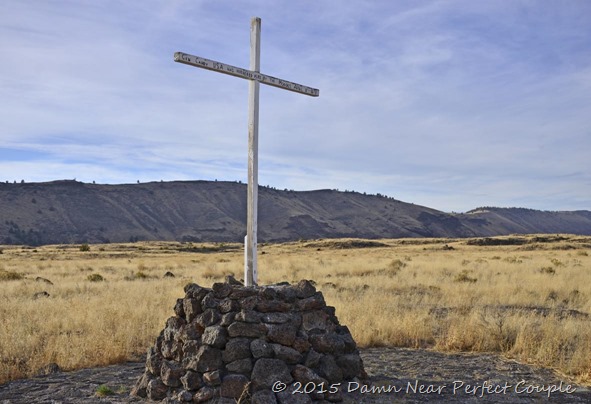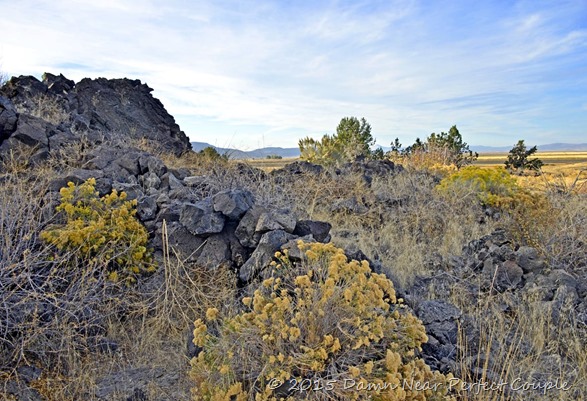 Apparently that same frustration existed in this small town, as we were greeted with this sign on entering town. I had to wonder if the girls teams were known as the “Lady Honkers”….and is the Junior Varsity the “Quackers”?
Apparently that same frustration existed in this small town, as we were greeted with this sign on entering town. I had to wonder if the girls teams were known as the “Lady Honkers”….and is the Junior Varsity the “Quackers”?OK, enough of that.
We spent a couple of days in the one-store town of Tionesta, population 30, at a nice little park called the Hawk’s Nest. From there we drove to Lower Klamath Falls National Wildlife Refuge, established in 1908 as the nation’s first migratory bird refuge. Over 80 percent of the Pacific Flyway’s migratory waterfowl stop here, and the 50,000 plus acres of lakes and marsh attract thousands of ducks, pelicans, and birds. Although we visited during the early part of the migration, the lakes were covered in Coots, Grebes, White Pelicans, and a variety of ducks:
We watched as the White Pelicans, surrounded by Grebes and Coots, gathered in a group to drive fish into the shallows:
We enjoyed the refuge, but were fascinated by the Lava Beds National Monument, a place we’d never heard of.
 Covering over 46,000 acres, the monument is a beautiful area of lava flows, canyons, and lush desert. Two things made this place special for us; history and caves. The history of the area is extensive, but we were especially interested in the Modoc Indian Wars that took place here. Briefly, during the winter of 1882-83, a small band of Modoc Indians led by Keintpoos, known as “Captain Jack” refused to remain on the reservation and entrenched themselves in the lava beds. Scattered fighting ensued until in January 1873 when the Army attacked the Modocs in force. Fighting in fog, cold, and the confusing terrain of the lava beds, the Army, defeated, gave up the fight. This was followed by a number of meetings between Captain Jack and the Army, led by Brigadier General E.R.S. Canby, a Civil War veteran. No progress was made, and the Modocs, believing that if they killed the enemy leader the Army would give up, ambushed the General at a meeting, killing him. General Canby was the first general killed in the Indian wars, and as a result, the Army ordered an additional 1000 troops into the area. Eventually Captain Jack was captured, and he was convicted of murder and hung in October 1873.
Covering over 46,000 acres, the monument is a beautiful area of lava flows, canyons, and lush desert. Two things made this place special for us; history and caves. The history of the area is extensive, but we were especially interested in the Modoc Indian Wars that took place here. Briefly, during the winter of 1882-83, a small band of Modoc Indians led by Keintpoos, known as “Captain Jack” refused to remain on the reservation and entrenched themselves in the lava beds. Scattered fighting ensued until in January 1873 when the Army attacked the Modocs in force. Fighting in fog, cold, and the confusing terrain of the lava beds, the Army, defeated, gave up the fight. This was followed by a number of meetings between Captain Jack and the Army, led by Brigadier General E.R.S. Canby, a Civil War veteran. No progress was made, and the Modocs, believing that if they killed the enemy leader the Army would give up, ambushed the General at a meeting, killing him. General Canby was the first general killed in the Indian wars, and as a result, the Army ordered an additional 1000 troops into the area. Eventually Captain Jack was captured, and he was convicted of murder and hung in October 1873.  Walking the trail through the area where the battles took place it’s easy to see how difficult it was to find and dislodge the Modocs. The broken lava provided nooks, crannies, and natural fighting positions, many of which are still visible today. Although it’s an area of rock and desert, it’s still a beautiful place to stroll.
Walking the trail through the area where the battles took place it’s easy to see how difficult it was to find and dislodge the Modocs. The broken lava provided nooks, crannies, and natural fighting positions, many of which are still visible today. Although it’s an area of rock and desert, it’s still a beautiful place to stroll. A bit down the road, we came to the site of General Canby’s murder and a replica of the original marker:
A bit down the road, we came to the site of General Canby’s murder and a replica of the original marker:
 The other fascinating thing about this area is the caves – nearly 800 have been mapped. These are lava tube caves – some are large and developed with trails, some are “ice caves” that contain ice year around, and others run the gamut from easily accessible to those that require scrambling on hands and knees. What we found remarkable is the open access – just visit the interpretive center, answer questions to be screened for white-nosed syndrome, check out a helmet and flashlight if you like, then go caving. You’re on your own, a remarkable approach to exploring a cave these days.
The other fascinating thing about this area is the caves – nearly 800 have been mapped. These are lava tube caves – some are large and developed with trails, some are “ice caves” that contain ice year around, and others run the gamut from easily accessible to those that require scrambling on hands and knees. What we found remarkable is the open access – just visit the interpretive center, answer questions to be screened for white-nosed syndrome, check out a helmet and flashlight if you like, then go caving. You’re on your own, a remarkable approach to exploring a cave these days. We normally think of lava beds are pretty desolate; but driving through the monument provided some truly beautifully vistas:


Finally, as we drove through the area, we came across this remarkably healthy looking coyote. It’s not often we have the opportunity to see such a beautiful animal, and it seemed to enjoy the attention:


We’ve made it back to Benson, AZ and the Escapees park where we’ll be spending the winter months. We still have more travel to catch up on, so look for another blog soon!


